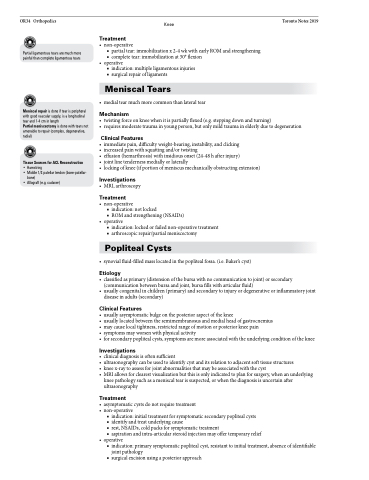Page 968 - TNFlipTest
P. 968
OR34 Orthopedics
Knee Toronto Notes 2019
Partial ligamentous tears are much more painful than complete ligamentous tears
Meniscal repair is done if tear is peripheral with good vascular supply, is a longitudinal tear and 1-4 cm in length
Partial meniscectomy is done with tears not amenable to repair (complex, degenerative, radial)
Tissue Sources for ACL Reconstruction
• Hamstring
• Middle 1/3 patellar tendon (bone-patellar-
bone)
• Allograft (e.g. cadaver)
Treatment
• non-operative
■ partial tear: immobilization x 2-4 wk with early ROM and strengthening ■ complete tear: immobilization at 30° flexion
• operative
■ indication: multiple ligamentous injuries ■ surgical repair of ligaments
Meniscal Tears
• medialtearmuchmorecommonthanlateraltear
Mechanism
• twistingforceonkneewhenitispartiallyflexed(e.g.steppingdownandturning)
• requiresmoderatetraumainyoungperson,butonlymildtraumainelderlyduetodegeneration
Clinical Features
• immediatepain,difficultyweight-bearing,instability,andclicking • increasedpainwithsquattingand/ortwisting
• effusion(hemarthrosis)withinsidiousonset(24-48hafterinjury) • jointlinetendernessmediallyorlaterally
• lockingofknee(ifportionofmeniscusmechanicallyobstructingextension)
Investigations
• MRI, arthroscopy
Treatment
• non-operative
■ indication: not locked
■ ROMandstrengthening(NSAIDs)
• operative
■ indication: locked or failed non-operative treatment ■ arthroscopic repair/partial meniscectomy
Popliteal Cysts
• synovial fluid-filled mass located in the popliteal fossa. (i.e. Baker’s cyst)
Etiology
• classified as primary (distension of the bursa with no communication to joint) or secondary (communication between bursa and joint, bursa fills with articular fluid)
• usually congenital in children (primary) and secondary to injury or degenerative or inflammatory joint disease in adults (secondary)
Clinical Features
• usually asymptomatic bulge on the posterior aspect of the knee
• usually located between the semimembranosus and medial head of gastrocnemius
• may cause local tightness, restricted range of motion or posterior knee pain
• symptoms may worsen with physical activity
• for secondary popliteal cysts, symptoms are more associated with the underlying condition of the knee
Investigations
• clinical diagnosis is often sufficient
• ultrasonography can be used to identify cyst and its relation to adjacent soft tissue structures
• knee x-ray to assess for joint abnormalities that may be associated with the cyst
• MRI allows for clearest visualization but this is only indicated to plan for surgery, when an underlying
knee pathology such as a meniscal tear is suspected, or when the diagnosis is uncertain after ultrasonography
Treatment
• asymptomatic cysts do not require treatment • non-operative
■ indication: initial treatment for symptomatic secondary popliteal cysts
■ identify and treat underlying cause
■ rest, NSAIDs, cold packs for symptomatic treatment
■ aspiration and intra-articular steroid injection may offer temporary relief
• operative
■ indication: primary symptomatic popliteal cyst, resistant to initial treatment, absence of identifiable
joint pathology
■ surgical excision using a posterior approach


